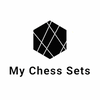Introduction to Choosing the Right Chess Set Size
Choosing the right chess set size is crucial for players of all levels, whether you're a beginner or an experienced player engaging in tournament play. The size of the chess set can affect your enjoyment and effectiveness in the game. It is not merely about the aesthetic appeal but also the practicality and suitability of the set for the environment in which it will be used. In this article, we'll explore the various elements to consider when selecting the size of your chess set, including the sizing conventions, different materials, and specific use-case scenarios.
Understanding Chess Set Dimensions
When we talk about the size of a chess set, we refer primarily to the size of the board and the pieces. The key measurements you need to know are the dimensions of the squares on the board and the height of the king, which is generally used as a reference point for the pieces' scale.
1. The Chess Board
The board itself is made up of 64 squares, laid out in an 8x8 grid. Each square should be large enough to accommodate the pieces without appearing cramped or causing confusion during play. As per the rule of thumb, the size of the square should be approximately 1.25 to 1.3 times the diameter of the base of the king.
2. The Chess Pieces
Chess pieces come in various sizes, typically measured by the height of the king. But the proportion of all pieces should be consistent with the size of the king to maintain aesthetic and functional harmony.
Official Size Recommendations
For competitive play, specific sizes and standards have been set by chess governing bodies such as FIDE (Fédération Internationale des Échecs or International Chess Federation). FIDE's recommended chess piece size for tournaments is a king height of approximately 3.75 inches, and the square size of the board should be about 2 to 2.5 inches.
FIDE Standards
FIDE also suggests that the diameter of the base of the king should not be more than 75% of the width of a square. This provides a clear visual and practical space between the pieces, reducing the chance of accidental knocks or difficulty in distinguishing the game state.
Factors to Consider When Choosing Your Chess Set Size
Several factors will guide your decision when choosing the size of your chess set. These include the user's age and experience, the location where you intend to use the set, personal preferences, and whether the set is primarily for practice, decoration, or competition.
User Age and Experience
For children or chess beginners, a larger set with easily identifiable pieces might be preferable, which makes it easier to grasp the game's fundamentals without struggling to differentiate the pieces. Experienced players may prefer standard-sized or smaller sets that are used in tournament play, as this can help in practice consistency.
Location and Frequency of Use
If you're purchasing a chess set for a club or public space, a larger, more durable set might be ideal. In contrast, a personal, more portable chess set could be smaller and made from finer materials if it is for more casual or display purposes.
Personal Preference and Intended Use
If your chess set is meant for decorative purposes, size and material might be influenced heavily by aesthetic preferences. For practice, consider a set that mimics the sizes used in tournaments. This can be a critical factor for serious players who participate in competitions.
Material Choices and Their Impact on Chess Set Sizes
The material of the chess pieces and board can influence your choice of size. Each material has different qualities in terms of weight, durability, and aesthetics.
Wooden Chess Sets
Wood is the most traditional material and varies greatly in texture and density. Larger wooden sets are generally durable and have a classic, elegant appearance, making them ideal for both playing and decoration.
Plastic Chess Sets
Plastic sets are lighter and usually more affordable, making them suitable for schools and regular transport. They come in standard sizes, which are ideal for practice and casual play.
Metal Chess Sets
Metal sets can vary significantly in size and weight. Smaller metal sets are heavier, providing a stable game play experience, but might be less convenient to move frequently.
Navigating Size in Different Chess Set Styles
From travel chess sets to larger garden chess sets, the intended style of play significantly influences the size of your chess set.
Travel Chess Sets
Travel sets are compact and portable, designed to be used while on the move. These sets often come with smaller pieces and a roll-up board or a small, foldable board.
Tournament Chess Sets
These sets adhere to official size standards suitable for professional and competitive play. They are typically larger, with a robust and durable design.
Novelty and Decorative Sets
Often crafted for aesthetic appeal rather than functional play, novelty chess sets can vary greatly in size and design. The pieces might be larger and more detailed, which requires larger squares and, therefore, a larger board.
Garden Chess Sets
For outdoor spaces, garden chess sets are significantly larger, designed for play at garden parties or in parks. These pieces can be upwards of several feet tall.
Conclusion
Choosing the right chess set size involves considering multiple factors including the players' age and experience, the setting in which the set will be used, and specific material preferences. Whether for competitive play, casual use, or decorative purpose, the right chess set size enhances the playing experience, allowing players to enjoy the game to its fullest. By understanding the sizing norms and considering your personal or organizational needs, you can select a chess set that is both beautiful and functional.
Explore our large collection of luxurious chess sets!